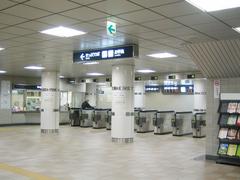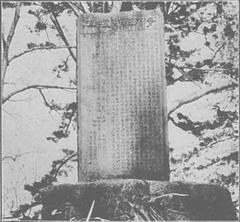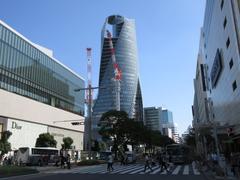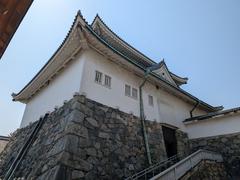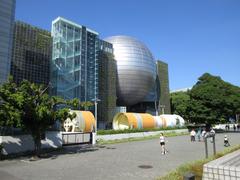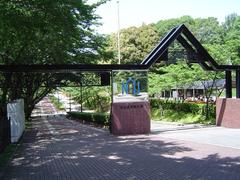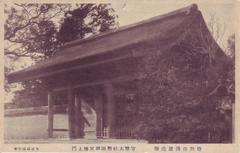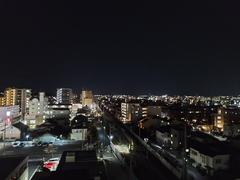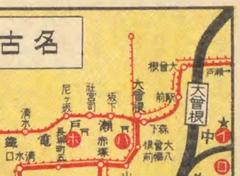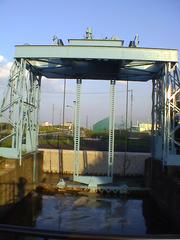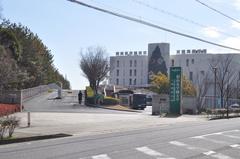Visiting 松山新栄町線;オオカンザクラの並木道 in Nagoya, Japan: Hours, Tickets, and Tips
Published Date: 01/08/2024
Introduction to 松山新栄町線;オオカンザクラの並木道
Discover the enchanting Ōkanzakura no Namiki Michi along the 松山新栄町線 in Nagoya, Japan. This cherry blossom-lined pathway is not only a botanical marvel but also a cultural and historical treasure. Established in the early 1960s, this 1.4-kilometer-long avenue features approximately 140 Ōkanzakura trees, a hybrid species known for its early blooming period. The pathway is a popular hanami (flower viewing) destination, attracting both locals and tourists eager to experience the breathtaking beauty of the early blooming cherry blossoms (source).
Ōkanzakura trees, scientifically known as Cerasus × kanzakura ‘Ō-kanzakura,’ are a hybrid species believed to be a cross between the Kanhi-zakura and either the Ōshima-zakura or the Yamazakura. These trees are characterized by their pale pink flowers that bloom in early March, signaling the arrival of spring in Nagoya. The pathway offers a serene and immersive environment, enhanced by the continuous canopy of blossoms that create a tunnel-like effect (source).
This guide provides comprehensive information to help you make the most of your visit, including historical background, visitor information, cultural significance, and travel tips. Whether you’re a seasoned traveler or a first-time visitor, this guide will ensure a memorable experience at one of Nagoya’s most cherished landmarks.
Contents Overview
- Introduction
- Historical Background
- Visitor Information
- Visiting Hours
- Tickets
- Best Time to Visit
- Botanical Significance
- Cultural Importance
- Community and Social Impact
- Ecological Contributions
- Architectural and Aesthetic Value
- Economic Impact
- Preservation Efforts
- Future Prospects
- Nearby Attractions
- Travel Tips
- Accessibility
- FAQ
- Conclusion
Historical Background
The Ōkanzakura no Namiki Michi in Nagoya, Japan, is a historically significant site that dates back to the early 1960s. The inception of this beautiful cherry blossom pathway began in 1961 when local residents expressed a desire to have the earliest blooming cherry trees in the city. This led to the planting of 16 Ōkanzakura saplings, a hybrid cherry tree known for its early blooming period. Over the years, the number of trees has grown to approximately 140, creating a stunning 1.4-kilometer-long pathway of cherry blossoms (source).
Visitor Information
- Visiting Hours: The Ōkanzakura no Namiki Michi is open to the public 24 hours a day, but the best time to visit is during daylight hours to fully appreciate the beauty of the cherry blossoms.
- Tickets: Entry to the pathway is free of charge, making it an accessible attraction for everyone.
- Best Time to Visit: The cherry blossoms typically bloom in early March. For the most up-to-date information, check social media updates from the local government.
Botanical Significance
Ōkanzakura (Cerasus × kanzakura ‘Ō-kanzakura’) is a hybrid species believed to be a cross between the Kanhi-zakura (Prunus campanulata) and either the Ōshima-zakura (Prunus speciosa) or the Yamazakura (Prunus jamasakura). This hybridization results in a tree that blooms earlier than the more common Somei-Yoshino cherry trees, typically starting in early March. The flowers of the Ōkanzakura are characterized by their pale pink color, which appears almost white from a distance when they first bloom and gradually turn pink as they begin to fall (source).
Cultural Importance
The Ōkanzakura no Namiki Michi holds a special place in the hearts of Nagoya’s residents and visitors alike. It is one of the first places in the city where people can enjoy hanami (flower viewing) each year. The early blooming period of the Ōkanzakura makes it a highly anticipated event, often signaling the arrival of spring. The pathway is not only a popular spot for locals but also attracts tourists from all over Japan and beyond, eager to witness the breathtaking beauty of the cherry blossoms.
Community and Social Impact
The establishment of the Ōkanzakura no Namiki Michi has had a profound impact on the local community. It has become a symbol of the area’s natural beauty and a source of pride for residents. The pathway is maintained with great care, and the local government, along with community volunteers, ensures that the trees are well-preserved and the area remains clean and welcoming for visitors. During the blooming season, the local government provides regular updates on the flowering status through social media platforms like Twitter and Facebook, helping visitors plan their trips (source).
Ecological Contributions
The Ōkanzakura trees contribute significantly to the local ecosystem. As early bloomers, they provide an essential source of nectar for pollinators such as bees, which are crucial for the pollination of many other plants in the area. The trees also offer habitat and food for various bird species, enhancing the biodiversity of the region. The presence of these trees helps to improve air quality and provides shade, contributing to the overall environmental health of the area.
Architectural and Aesthetic Value
The design and layout of the Ōkanzakura no Namiki Michi are carefully planned to maximize the aesthetic appeal of the cherry blossoms. The trees are planted in a way that creates a continuous canopy of flowers, forming a tunnel-like effect that is both visually stunning and immersive. This design not only enhances the beauty of the pathway but also provides a serene and tranquil environment for visitors to enjoy. The pathway is easily accessible from the Takaoka Station on the Sakuradori Line, making it a convenient destination for both locals and tourists (source).
Economic Impact
The annual blooming of the Ōkanzakura trees has a positive economic impact on the local area. The influx of tourists during the cherry blossom season boosts local businesses, including restaurants, shops, and hotels. Special events and festivals are often organized around the blooming period, attracting even more visitors and generating additional revenue for the community. The pathway’s popularity also helps to promote Nagoya as a tourist destination, contributing to the city’s overall tourism industry.
Preservation Efforts
Preserving the Ōkanzakura no Namiki Michi is a priority for the local government and community. Regular maintenance and care are essential to ensure the health and longevity of the trees. Efforts include pruning, pest control, and soil management to provide optimal growing conditions. The community also engages in educational programs to raise awareness about the importance of preserving these trees and the role they play in the local ecosystem and culture (source).
Future Prospects
Looking ahead, the future of the Ōkanzakura no Namiki Michi appears promising. Continued efforts to maintain and enhance the pathway will ensure that it remains a cherished landmark for generations to come. Plans for expanding the pathway and planting additional trees are being considered, which would further enhance its beauty and appeal. The local government is also exploring ways to incorporate more sustainable practices in the maintenance of the pathway, ensuring that it remains an environmentally friendly and sustainable attraction.
Nearby Attractions
While visiting Ōkanzakura no Namiki Michi, consider exploring other nearby attractions in Nagoya such as Nagoya Castle, Atsuta Shrine, and the Toyota Commemorative Museum of Industry and Technology. These historical sites offer a deeper insight into the rich cultural heritage of the region.
Travel Tips
- Getting There: The pathway is easily accessible from the Takaoka Station on the Sakuradori Line.
- Photography: Early morning or late afternoon provides the best lighting for capturing the cherry blossoms.
- Amenities: Nearby facilities include restrooms, cafes, and souvenir shops.
Accessibility
The pathway is wheelchair accessible, making it inclusive for all visitors. There are also several benches along the route for those who wish to rest and take in the scenery.
FAQ
- When is the best time to visit Ōkanzakura no Namiki Michi? The best time to visit is during early March when the cherry blossoms are in full bloom.
- How to get to Ōkanzakura no Namiki Michi? The pathway is conveniently accessible from the Takaoka Station on the Sakuradori Line.
- Are there guided tours available? While there are no official guided tours, local volunteers often provide informal tours during the blooming season.
Conclusion
In summary, the Ōkanzakura no Namiki Michi in Nagoya is a site of great historical, cultural, and ecological significance. Its early blooming cherry blossoms provide a unique and beautiful experience for visitors, while also contributing to the local community and economy. The pathway’s preservation and future development will ensure that it continues to be a beloved destination for years to come. Don’t forget to download the Audiala app for more travel tips and updates, and follow us on social media for the latest news.
Sources and References
- Discover the charm of Ōkanzakura no Namiki Michi in Nagoya, a historically and culturally significant pathway lined with early-blooming cherry trees. (dera-nagoya-dash.jp).
- Ōkanzakura (Cerasus × kanzakura ‘Ō-kanzakura’) is a hybrid species believed to be a cross between the Kanhi-zakura (Prunus campanulata) and either the Ōshima-zakura (Prunus speciosa) or the Yamazakura (Prunus jamasakura). (aichi-now.jp).
- The pathway is maintained with great care, and the local government, along with community volunteers, ensures that the trees are well-preserved and the area remains clean and welcoming for visitors. (city.nagoya.jp).

